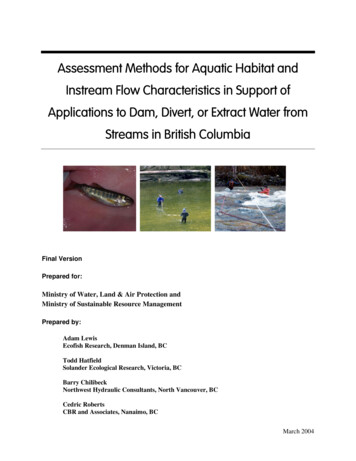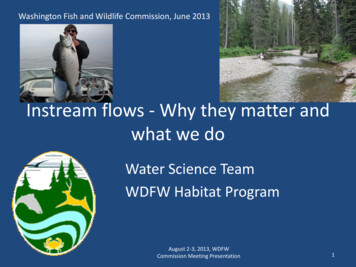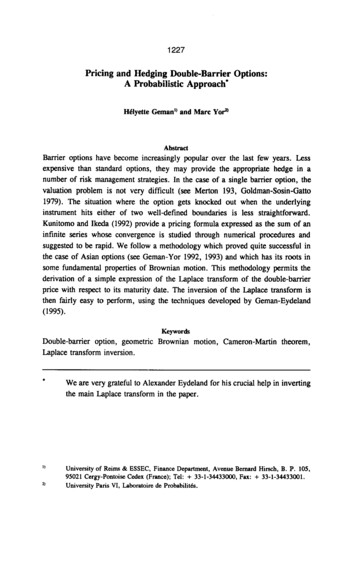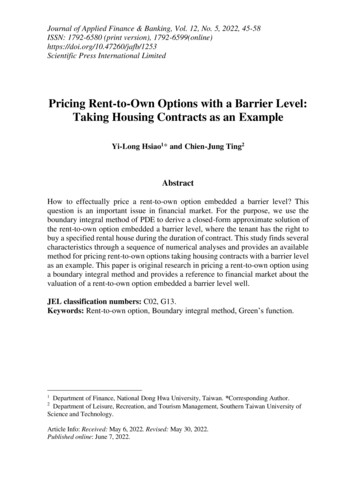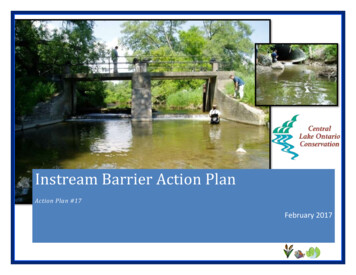
Transcription
Instream Barrier Action PlanAction Plan #17February 2017
Instream Barrier Action PlanFebruary 2017Contents1.INTRODUCTION . 1-11.1PURPOSE . 1-11.2CONTEXT OF THIS ACTION PLAN AND WATERSHED PLANNING . 1-22.METHODOLOGY . 2-13Top Barriers For Removal. 3-14Lynde Creek Watershed . 4-15Oshawa Creek Watershed. 5-16Black/Harmony/Farewell Creek Watershed . 6-17Bowmanville/Soper Creek Watershed . 7-18Small Watersheds . 8-19CONCLUSION . 9-110 REFERENCES . 10-111 Appendix 1 – Lynde Creek Watershed . 11-112 Appendix 2 - Oshawa Creek Watershed . 12-113 Appendix 3 - Black/Farewell/Harmony Creek Watershed . 13-114 Appendix 4 - Bowmanville/Soper Creek Watershed . 14-115.0 Appendix 5 - Small Watersheds . 15-1
Instream Barrier Action PlanFebruary 2017EXECUTIVE SUMMARYThis document assesses all known instream barriers that are potentially impacting fish movement within the CLOCA jurisdiction. Each instreambarrier has been documented using standardized metrics, including: quality of biotic life within proximity of barrier; extent of barrier; quantity ofhabitat restricted; quality of habitat restricted; and other considerations for barrier removal. Scores are allocated to each of these metrics andthe overall score summed to determine relative importance of removal. Individual barrier information is presented in the appendices to this reportand are organized by watershed. Based upon the scores in each watershed, the top 10 barriers recommended for removal are presented in Section3. Oshawa and Bowmanville Soper Creek accounted for 8 of the 10 barriers and Black/Harmony/Farewell and Lynde Creek watersheds had oneeach in the top 10. There were nobarriers in the Small watersehdsidentified for removal in the top 10 list.Prioritizing barriers for removal in thismanner places an emphasis on restoringbarriers located in the healthiest sectionsof the watershed and where sensitivespecies are abundant. Natural barriers(debris barriers, beaver dams) were notconsidered as they are temporary andpart of a natural system.The only watershed not found in the top10 barriers for removal section are theSmall Watersheds.This Instream Barrier Action Plansupports implementation ofrecommendations contained within CLOCA’s Watershed Plans including the evaluation of instream barriers to assess whether barriers need tobe removed and prioritizing of barriers for removal. With this information in hand, CLOCA can work with our partners on improving aquatichabitat throughout the jurisdiction.
Instream Barrier Action Plan1.February 2017INTRODUCTIONInstream barriers may be any type of water control structure, culvert, or weir that obstructs or limits fish movement from accessing habitat, orcauses fish to congregate at the base of the barrier for prolonged time periods. Not only do instream barriers have direct effects on fish, but theyalso effect water quality and habitat conditions within the stream. Impoundment of water behind a physical structure causes the sediment tosettle out from the stream water, leading to silt build-up in the pond and sediment deprivation downstream. Sediment deprivation downstreamof the barrier causes an increased rate of stream bank erosion as the sediment-reduced water has more energy to scour stream banks. The higherenergy flow can also increase erosion of sediments in depositional areas of the lower stream reaches. Sediment accumulation in a pond requiresperiodic dredging. If a pond is not properly managed, the amount of sediment accumulates and water capacity in the pond is restricted. Thiseventually results in sediment being carried over the barrier and flushed downstream smothering fish spawning beds and habitat.Instream barriers can disconnect resident fish communities. There is some uncertainty if this is beneficial or detrimental to certain nativecommunities. Brook Trout, for example, were distributed throughout the watersheds historically. Currently, they live primarily in headwater areas,where suitable conditions still exist, and are generally disconnected, by instream barriers, from competing populations of non-native Salmon andTrout. Limited competition is thought to be beneficial for protecting native Brook Trout populations. However, the isolation of Brook Troutconspecific populations can cause a genetic bottleneck effect, resulting in population declines long-term. In addition, by having a barrier in placeit limits their ability to avoid stochastic events, long-term climate change impacts, reduces the number of life history strategy options (e.g.migratory or residential), and limits dispersal for the purpose of exchanging genetics and repopulating neighbouring habitat. Barriers can also actas an obstacle, controlling upstream movement of invasive aquatic species. It is unclear which factor is more relevant to the success of upstreamfish species, therefore, further site specific research may be warranted where these situations arise.1.1 PURPOSEThe identification and evaluation of instream barriers is an important component in Central Lake Ontario Conservation Authority’s (CLOCA’s)efforts to protect, restore and enhance fish and aquatic habitat. Most barriers within CLOCA’s jurisdiction have been assessed through variousdam inventory projects. The purpose of this report is to create a barriers action plan prioritizing removal of instream barriers. Existing instreambarriers impact on aquatic ecosystems were evaluated watershed wide. The result is a prioritization of instream barriers for removal. Prioritizationwas assessed using five metrics associated with the site and upstream watershed. Metrics included were quality of biotic life, habitat quality andquantity upstream, the extent of the barrier, and the risks associated with removing the dam. It is recognized that the biological considerations donot take into account important cultural, social and economic factors associated with the barriers. When known, these considerations will bementioned but not factor into the prioritization scoring. This report classifies barrier removal on a biological basis only. Knowing what barriers willPage 1- 1
Instream Barrier Action PlanFebruary 2017provide the best value, in terms of ecological improvement, is important when selecting one of many barriers in a watershed. The informationpresented in this Action Plan provides the rationale needed to support restoration and funding opportunities.It is acknowledged that there are data gaps around some of the barriers. In most cases the lack of information is a result of barriers being locatedon private property. When new data becomes available, this information will be incorporated into this document. Barriers caused by debris jamsor beaver activity were not considered in this Action Plan as these are deemed to be ‘temporary natural’ barriers. When these barriers come toour attention, CLOCA staff will assess the barrier and provide the municipality/landowner with appropriate recommendations.1.2 CONTEXT OF THIS ACTION PLAN AND WATERSHED PLANNINGThe goal of watershed planning is to provide a framework to protect, restore and enhance a healthy and resilient watershed. A Watershed Planexamines the environment and human activities within a watershed area and assesses the relationships between these activities to determinehow the ecosystems of the watershed should be managed to ensure that they retain their ecological integrity. In 2012 and 2013, WatershedPlans for CLOCA’s 4 large watersheds were completed; the Watershed management recommendations that were made in these plans will, whenimplemented, work to achieve specific watershed goals and targets. In order to achieve these goals, CLOCA identified a suite of tools, including24 Action Plans, to direct and support the implementation of the Watershed Plan recommendations. Action Plan #17, The Instream Barriers ActionPlan, investigates and evaluates known barriers to confirm ecological impact on aquatic functions, necessity to remove the barrier and to prioritizebarrier removal.CLOCA Action PlansThe 24 Action Plans described in the Watershed Plans work to achieve specific health objectives, contributing to the fundamental goal of ahealthy and resilient watershed. All of the Action Plans address watershed concerns, issues and actions identified during development of theWatershed Plans. These plans will provide greater detail for achieving specific watershed goals and targets, and will provide the framework andimplementation planning necessary to complete future on-the-ground monitoring, research, restoration and rehabilitation work. Some of theAction Plans are designed to be implemented at a larger scale, i.e., the CLOCA jurisdiction, while other Action Plans will be directed to specificwatersheds, subwatersheds, or even a site specific area. While CLOCA is taking the lead on preparing these Action Plans, the completion of somespecific plans will compliment, support and/or inform Regional and/or Municipal programs. These plans will provide greater detail for achievingspecific watershed goals and targets, and will provide the framework and implementation planning necessary to complete future on-the-groundmonitoring, research, restoration and rehabilitation work.Action Plan #17; The Instream Barrier Action Plan will identify and evaluate existing instream barriers. Five metrics were considered in theevaluation of each barrier: quality of biotic life in proximity to the barrier; extent of passage; quantity of upstream habitat restricted; quality ofPage 1- 2
Instream Barrier Action PlanFebruary 2017upstream habitat restricted; and other considerations for barrier removal. This evaluation enables the priorization of barrier removal throughoutthe jurisdiction and within individual watersheds.Planning ContextCLOCA provides planning advice, as set out in a Memorandum of Understanding (MOU), with our partner municipalities. This MOU recognizesCLOCA’s expertise in the areas of watershed management, natural heritage and natural hazard planning, and identifies CLOCA as the agency toprovide advice and comments on these matters. CLOCA not only provides comments on planning applications relating to the identification,function and significance of natural heritage and hydrological features and systems, and reviews studies that assess impacts on watershedresources, advice is also provided to support the implementation of the Authority’s resource management plans including Watershed Plans andAction Plans. CLOCA also reviews and comments on projects conducted in accordance with the Environmental Assessment Act, bringing localenvironmental and watershed knowledge into the review andassessment process.A number of instream barriers areassociated with the transportation network (road crossings).The knowledge gained through this Action Plan provides moreinformation important in the consideration, review andrestoration recommendations associated with municipal capitalprojects and infrastructure improvements.CLOCA’sinvolvement in both the local land use and EA review processesensures that regard for the integrity of the Natural HeritageSystem (NHS) can be maintained throughout the planningprocess, and the information and recommendations containedwithin this Action Plan can be applied.Page 1- 3
Instream Barrier Action Plan2.February 2017METHODOLOGYPrioritization RationaleThis action plan focuses on the biological concerns of removing barriers and makes note of cultural, economic, and social concerns if known. Thecultural, economic and social concerns will not factor into the score. The following outlines each of the metrics considered for assessing thebenefits of barrier removal. There are a total of five metrics. Four of the metrics are assessed a quantitative score outlined below. One metric,other considerations for barrier removal, is qualitative. The four quantitative metrics are scored out of five for a total possible score of 20. Thehigher the score, the more beneficial removing the barrier, from a biological standpoint. The qualitative metrics acts as a red flag and can signalwhen more background research is necessary prior to barrier removal.Metric: Quality of Biotic Life Within Proximity of BarrierWithin the jurisdiction of the Central Lake Ontario Conservation Authority, there are highly diverse natural features and differing amounts ofhuman alteration that impact the composition of fish communities. Different fish communities have different habitat needs, migration strategies,and ecological, recreational and economical significance. For example, typically, Blacknose Dace are more adaptable and tolerant to changes inhabitat and water quality than Slimy Sculpin. Generalist species can thrive in nearly any habitat and for this reason, there is greater benefit inimproving connectivity where sensitive species exist.This metric can be scored using an Index of Biotic Integrity (IBI). The purpose of the IBI is to translate the fish community information into astream health score. Since each species of fish have different sensitivities and tolerances, understanding the composition of the community canprovide insight into the biological integrity or health of that site. Generally, if a site is dominated by sensitive, coldwater species, it will result in ahigher score, whereas, areas dominated by species very tolerant to land use change will have a lower score. The average IBI score between thenearest sites upstream and downstream is used. For sites to be considered, they must be located before any major confluences and without anysignificant feature between it and the barrier. In order for an IBI score to be awarded, certain criteria must be met to ensure consistent andcomparable data (e.g. sampled using the Ontario Stream Assessment Protocol (OSAP)). The IBI is scored out of 100, therefore, the average IBIscore will be divided by 20 to have a maximum score of 5 for high quality fish communities and a minimum score of 0 for low quality fishPage 2-1
Instream Barrier Action PlanFebruary 2017communities. For more information on the IBI and how it determines quality of the fish community, please refer to the Central Lake Ontario IBIMethodology.Metric: Extent of BarrierAll barriers are not created equal. Some are vertical barriers while others create velocity barriers. Fish species vary in their ability to overcomeeach of these types of barriers. Rainbow Trout, for example, are able to overcome some vertical barriers by jumping, if given the right conditions(e.g. pool depth), but may not be able to overcome certain velocity barriers within a long straight stretch of culvert. Although adult Salmonids(Rainbow Trout, Chinook Salmon, etc.) may be able to pass vertical barriers, most other fish are not capable of jumping and this will be a barrierat any stage of their life. Also, an area may become impassible at different life stages orduring different flow conditions.This metric was divided into three categories. The first consists of barriers that are onlyconsidered a barrier to small, non-jumping fish that are not known to migrate longdistances (e.g. most “minnows”) and will be scored a one. The second is any barrier nonjumping fish are not able to pass, including larger migratory fish (e.g. Smallmouth Bass),and will receive a score of three. For example, Rainbow Trout are able to pass in the springbut low water levels prevent Chinook Salmon from passing in the fall. It would alsoinclude a barrier where migratory fish are spending too much time passing. Research hasdemonstrated the negativeimpacts of fish stacking up behindbarriers increasing the amout oftime required to migrate to spawninggrounds. Determining what is toomuch time is relatively arbitratry atthis point and is usually based onprofessional judgement. That beingsaid, certain situations may call forthe need to ascertain how long fishare taking to pass a barrier. The thirdPage 2-2
Instream Barrier Action PlanFebruary 2017category consists of barriers in which no fish can pass, be it a vertical barrier, low flow, or velocity barrier, and will be scored a five. A score of fivecan also be awarded to the following situations: areas where some Salmon and Trout are able to pass (Rainbow Trout and Chinook Salmon) but,other Salmon or Trout with limited jumping ability (e.g. resident Brook Trout), are present. The fragmentation of these resident populations couldhave genetic consequences and may be putting them at a disadvantage when competing against other migratory salmonids. Another situationwhere a score of 5 may be allocated is where species at risk are present and unable to pass (Redside Dace).Metric: Quantity of Habitat RestrictedThe quantity of habitat each barrier restricts is important when determining priority for removal. If all conditions associated with certain barriersare equal except one restricts access to 20km more stream length, it will be deemed more important to remove. This is calculated by measuringthe kilometers of upstream habitat that would be newly accessible to downstream fishes. If another barrier exists upstream, the additional areaaccessible would only be calculated up to the next barrier. These numbers will be re-calculated as barriers are removed that are in series withothers.In order to score this metric, all barriers had upstream habitat calculated. For every 10km of newly accessible habitat, 1 point is scored. Theminimum score is 0 which is applied when 0km is made accessible, and the maximum score is 5, based on 50km or more being made accessible.Since only a few sites had more than 50km of habitat upstream, it was decided to limit the score to 5 at 50km in order to have a more evenlydistributed metric.Metric: Quality of Habitat RestrictedThe biological importance of habitat upstream is dependent on the quality and type of habitat that exists. If, for example, upstream habitat ispoor quality and highly degraded with little habitat for specific purposes (e.g. spawning for Rainbow Trout), there is less incentive to restoreconnectivity. On the other hand, if the habitat is high quality and diverse, gravel beds and high groundwater input for example, there is moreincentive to restore connectivity as it could be beneficial habitat for many species, and specifically, spawning and refuge for Salmon and Trout.There are many factors that contribute to the quality of the upstream habitat. Generally speaking, the less anthropogenic disturbance upstreamof a barrier the better the habitat will be. Since there are many ways to measure disturbance, multiple measures were used for this metric. Watertemperature, riparian cover, and impervious surfaces are the three metrics that were used to determine the score.Page 2-3
February 2017Instream Barrier Action PlanHistorically, CLOCA’s jurisdiction was predominately a coldwater system. Deviation froma coldwater thermal regime will be synonymous with poorer water quality and increaseddisturbance. If the thermal regime has deviated to warmwater, the barrier will beassigned a score of one, coolwater will be assigned a score of three, and if the systemremains coldwater it will be scored a five. The scoring classifications are based oninstream temperature loggers that are part of the aquatic monitoring program at CLOCA.The data is analyzed and awarded a thermal designation based on the CLOCAtemperature analysis methodology.Adequate riparian cover can provide thermal benefits but is also associated with betterwater quality, reduced erosion, and more natural channel morphology. Adequateriparian cover is 30m on both sides of the creek as identified by Environment Canada inHow Much Habitat is Enough, 2013. If riparian cover upstream of the barrier is limited,the health of the stream may be impacted. Different thresholds appropriate for the CLOCA jurisdiction have been selected to separate high,average, and poor quality based on riparian cover. Percent riparian cover was divided by 20 to provide a score out of 5.The third component of habitat quality is upstream impervious surfaces. Impervious surfaces decrease water quality and alter ecological flows,which contributes to altered channel morphology and reduced channel diversity. Thegreater the amount of impervious cover upstream of the barrier, the more potential forvarious impacts and reduced quality of habitat. Impervious cover was calculatedupstream of the barriers. If impervious cover upstream of the site was greater than 20%,the score will be 0, and if 0%, the score will be 5. This puts the recommended thresholdnot to exceed 10%, (Environment Canada, 2013) at a score of 2.5. Conditions havedeviated from pristine, but there is still some potential for a good fish community.The final score for this section will be calculated by adding the score of eachcomponent, thermal, riparian and impervious cover, and dividing that sum by three tobe out of 5.Page 2-4
Instream Barrier Action PlanFebruary 2017It is understood that many different metrics could be used to provide an idea of habitat quality upstream. Percent forest cover, percent naturalcover, benthic invertebrate IBI, percent agricultural lands are a few examples. The three metrics outlined above were chosen in part because ofdata availability, but also because they have consistently been found to have strong relationships with fish community health within CLOCA.Metric: Other Considerations for Barrier RemovalLong-term barriers, especially those which have drastically changed stream form (e.g. pond habitat upstream), can significantly change manyaspects of stream flow dynamics and force biotic life to adapt to its new form. Simply removing the barrier can have negative effects on thedownstream habitat and the biotic life within the area that have adapted to this new form. Releases of large amounts of sediment and/orprotection of native Brook Trout populations may prove to be more valuable than increasingconnectivity for downstream biota. This metric will have to be assessed on an individual basis. IfBrook Trout populations are involved, genetic sampling should be completed to determine the longterm sustainability of those populations. In addition, comparing fish communities upstream anddownstream of the barrier to determine potential interspecific competition effects should becompleted. In regards to sediment, the amount that has accumulated upstream of the dam will haveto be determined, the quality of sediment that would be released, and if the release rate of sedimentcould be managed (e.g. stop logs). In some situations, barriers were created or are now maintainedto control the spread of invasive species. Certain barriers may be important to reduce accessible areaand/or spawning habitat for invasive species, such as, Sea Lamprey and Round Goby.Originally this metric was given a quantitative score, but it was found to influence the total scoretoo significantly. The scoring was changed to qualitative, and rather than contribute to the overallscore, it can be used as a flag for the barriers that have other considerations to be considered beforeremoval. If the score for a barrier is found to be high but the site has been flagged to have otherpotential biological concerns, the barrier will not be removed until these concerns can be assessed.Total ScoreAll scores will be summed to determine the barriers that are most beneficial for removal. The maximum possible score is 20 and the minimumscore is one. A barrier scoring one will have nearly no benefit for removal whereas a barrier scoring 20 is a high priority for removal from a biologicalperspective. These results can be used to actively try to mitigate barriers with the highest scores or to passively select the most suitable locationPage 2-5
Instream Barrier Action PlanFebruary 2017for barrier removal once resources becomes available. It allows for quick decisions to be made on sound biological reasoning. If any of the metricsimportance changes, it is relatively easy to adapt this document and the related scores within to reflect those changes to ensure an up-to-date,scientifically sound approach.When barriers have been restored, the metric scores will be removed from the evaluation sheet and restoration will be indicated. In somesituations, there may be limits to the amount of restoration that can occur. For example, BARBOW08 had passage improved, but full barrierremoval was not possible due to landowner uses and it’s role in Sea Lamprey control. Therefore, it remains a barrier but partial restoration will beindicated on its individual evaluation sheet.Page 2-6
February 2017Instream Barrier Action Plan3Top Barriers For RemovalWithin CLOCA, the top 10 barriers identified for priority removal are identified in Table 1. The only watershed not represented in the top 10 list isthe Small watersheds. The larger watersheds, specifically Bowmanville/Soper and Oshawa Creek, have barriers consistenly scoring high because itcontains the healthiest fish communities and habitat and are much larger. The larger watershed plays a role due to quantity of habitat restrictedbeing calculated as a metric. As this scoring system was meant to prioritize habitat for sensitive, specialist species, these results are expected. TheOshawa Creek Watershed has a total of 20 instream barriers, five of which fall within the top 10 barriers for removal. One barrier in both theBlack/Harmony/Farewell Creek Watershed (20 total barriers) and the Lynde Creek Watershed (11 total barriers) have been identified in the top10 for priority removal. Five of the barriers in the top 10 do have other considerations for removal (flagged as a yes these and highlighted yellowin the table below). These situations will need to be further investigated to ensure the disadvantages of removing the barrier do not outweigh theadvantages.Table 1: Summary of the top 10 barriers for removal based on biological metrics within the CLOCA jurisdiction.Page 3-1Quantity ofHabitatQuality ofHabitatOtherconsiderationsbefore removalTotal W05BAROSH14BAROSH06BAROSH16BARBOW09Extent ofBarrierBarrier CodeQuality ofBiotic LifeMetric 5.014.914.614.614.3
Instream Barrier Action PlanFebruary 2017This report will be revisited on a regular basis to update information, identify barriers that have been restored, or new barriers that have beendiscovered. It is important to note that landowner permission is required to gain access to many of these barriers and as landownership changesovertime, these permissions may also change, affecting future opportunities to gather more information or conduct restoration projects.Page 3-2
February 2017Instream Barrier Action Plan4Lynde Creek WatershedLynde Creek Watershed currently has 10 known barriers (Map 1). One barrier, the Hwy #7 Box Culvert, (BARLYN04) was removed through thewidening of Highway #7. Most of the existing barriers are found in the middle reaches or headwaters. BARLYN08 has th
specific watershed goals and targets, and will provide the framework and implementation planning necessary to complete future on-the-ground monitoring, research, restoration and rehabilitation work. Action Plan #17; The Instream Barrier Action Plan will identify and evaluate existing instream barriers. Five metrics were considered in the
